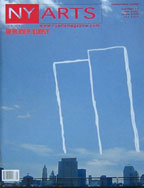

NY Arts Magazine, August 19, 2003
The Gryphons of Paris: A Reliquary of Photographs & Vignettes
by Ronald Hurwitz
Introduction by Françoise Reynaud
American concert violist Ronald Hurwitz brings his emotional tuning to bear on the visual world in The Gryphons of Paris, the premier publication from Voirin Editions. Hurwitz's work has taken a place in important Parisian collections including the Bibliothèque nationale, Musée Carnavalet, and the Maison Européenne de la Photographie; that feat confers upon him an artistic citizenship of which this beautiful book is the fruition.
Since 1979 he has been a frequent traveler to the French capitol and to Venice, international cities whose physical culture remains shaped by the prodigious growth of their power in the Nineteenth Century. Though Parisian life was transformed by the architectural autocracy of Baron Haussman in that period, the contemporaneous advent of photography provided the new Paris with an authenticating self-image. So its urban landscape remains permanently haunted by the visions of Eugène Atget, Édouard Baldus, Nadar, and the other giants of the medium's first phase.
When an American artist like Hurwitz turns his lens on the rue François Ier, the avenue Lédru-Rollin, the quai Voltaire, he repeats the originary labor of those pioneers while rotating it toward a modernity whose chronic nostalgia they could not have predicted. An imaginative daguerrotypist might anticipate the eventual rise of color photography, but not our aesthetic retrenchment upon monochrome that shows no sign of abatement. Every "black and white" photograph is a genealogy of the present, a grasp toward the Nineteenth Century's departed shades, the human and the monumental. Like Odysseus in the underworld, whose warm hands pass right through the cold ghost of his mother, photographers of the modern city are mourners for a past they never saw. Hurwitz calls The Gryphons of Paris a "reliquary." If the past is black and white, black and white is the past.
Any American citizen who makes the eastward crossing over the Atlantic is in some sense a pilgrim returning to the Old World; Hurwitz's three-decade career as a classical violist makes his voyages to the European capitols resonate with this sense of homecoming. The photographs of The Gryphons of Paris are those of a traveler, but they read like those of a lifelong resident. They open to us as invitations, subtly suggesting that we, too, can be at home here if only we will venture to identify with the heartbreakingly ephemeral beauty of its dark weather and eroding stone façades. In a similar way, indoor pictures like the desk-scape "Lundi 21 mars 1988" evoke a form of life that will soon be as irretrievable as those buildings that fell under the onslaught of Haussmanization a hundred years ago. The photo's title is the date of a single day that will never come again; its morning Figaro bears the partially legible headline "questions socialiste", questions which have since disappeared, not least because of the Soviet collapse which was only one year away at the time of this exposure. Even the paper-clipped handful of French money has since been replaced by the euro. Both architecturally and existentially, then. whatever still stands, stands for what could not stand.
Ronald Hurwitz Photography 32-5 Tyre Avenue, Toronto, Ontario, Canada M9A 1C5 416 465-5890